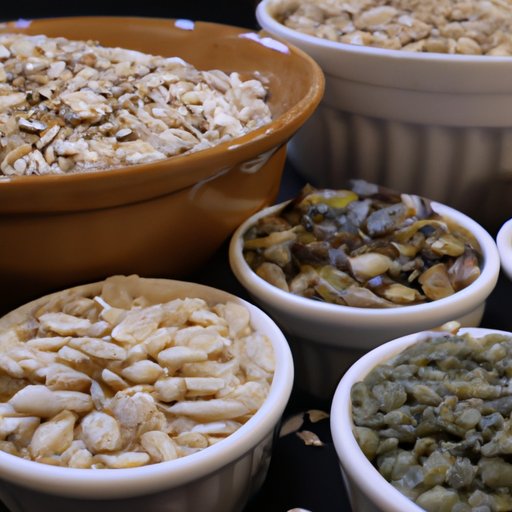
Are Whole Grains Gluten-Free? Exploring the Facts
Gluten-free diets have become increasingly popular in recent years, with many individuals choosing to eliminate gluten from their diets due to health concerns or personal preferences. However, there is often confusion about whether or not whole grains are safe for those following a gluten-free diet. In this article, we will explore the facts about whole grains and gluten, including definitions, health benefits, personal experiences, common misconceptions, preparing and cooking whole grains properly and recipe ideas.
Difference between Whole Grains and Gluten-Containing Grains
Whole grains are unprocessed grains that contain the bran, germ, and endosperm. These grains include quinoa, brown rice, oats, and corn, among others. Gluten-containing grains include wheat, barley, and rye. While some whole grains do contain gluten, there are also many gluten-free whole grains that can be safely consumed by those following a gluten-free diet. The following is a list of gluten-free whole grains:
- Quinoa
- Rice (brown, black, wild, and white)
- Oats (ensure they are labeled gluten-free due to cross-contamination concerns)
- Amarnath
- Buckwheat
- Corn
- Millet
- Sorghum
- Teff
- Wild Rice
It is important to note that some grains, such as corn and oats, can easily become contaminated with gluten during processing. Therefore, it is crucial to check the label and seek out certified gluten-free options when purchasing these grains.
Health Benefits of Consuming Whole Grains
Whole grains are an important part of a healthy diet, as they are excellent sources of fiber, B vitamins, and other crucial nutrients. Incorporating whole grains into a gluten-free diet can also help to reduce the risk of heart disease, obesity, and type 2 diabetes. However, some individuals following a gluten-free diet may be hesitant to consume whole grains due to concerns about gluten exposure.
While it is true that gluten can be harmful to those with celiac disease or gluten intolerance, most individuals can consume gluten-containing whole grains in moderation as part of a balanced diet. It is also important to remember that gluten-free whole grains, such as quinoa and brown rice, are excellent substitutes for gluten-containing grains, providing many of the same health benefits as well as added fiber and protein.
Prevalence of Gluten Intolerance and Celiac Disease
Celiac disease is an autoimmune disorder where the body cannot properly digest gluten, resulting in damage to the intestinal lining. It affects approximately 1% of the population. Gluten intolerance is a digestive disorder that affects an estimated 6% of the population. Individuals with these conditions must strictly avoid gluten in their diets to prevent symptoms and long-term health concerns.
While whole grains do contain gluten, evidence suggests that they are not a significant factor in the development of gluten intolerance or celiac disease. Instead, genetic factors and other environmental factors may play a larger role. Most individuals can consume whole grains without any adverse effects on their health.
Personal Experiences and Success Stories
Many individuals following a gluten-free diet have successfully incorporated whole grains into their meals, enjoying the health benefits and added flavor that they provide. By experimenting with different gluten-free whole grains and recipes, individuals can add variety and balance to their diets.
One success story comes from Sarah, who had struggled to find variety in her gluten-free diet until discovering the delicious flavors of quinoa. She now cooks with quinoa regularly, adding it to salads, soups, and even breakfast bowls. Sarah has also found that other gluten-free whole grains, such as millet and brown rice, can be easily incorporated into her meals to add texture and flavor.
Common Misconceptions
One common misconception about whole grains is that all whole grains contain gluten. While some whole grains do contain gluten, there are also many gluten-free whole grains that can be safely consumed by those following a gluten-free diet. It is also important to note that gluten-free grains should be carefully labeled and sourced to avoid cross-contamination issues.
Preparing and Cooking Whole Grains Properly
Properly preparing and cooking whole grains is crucial for maintaining their gluten-free status and avoiding cross-contamination with gluten-containing foods. The following tips can be helpful:
- Always check labels to ensure that the grains are certified gluten-free
- Store gluten-free grains separately and in airtight containers to avoid cross-contamination
- Rinse and sort grains before cooking to remove any debris or gluten-containing grains
- Cook gluten-free grains separately from gluten-containing grains.
Recipe Ideas and Suggestions
Incorporating whole grains into a gluten-free diet can be delicious and easy with the following recipe ideas:
- Quinoa and black bean salad with avocado and lime dressing
- Wild rice and vegetable stir fry
- Brown rice sushi rolls
- Millet and vegetable soup
- Corn and quinoa fritters
Conclusion
Whole grains can be a healthy and delicious addition to a gluten-free diet, providing important nutrients and flavors. By choosing certified gluten-free whole grains and properly preparing and cooking them, individuals can enjoy the health benefits of whole grains without compromising their gluten-free diet. Experimenting with different gluten-free whole grains and recipes can add variety and balance to a gluten-free diet, making it easier to maintain a balanced and satisfying eating plan.





